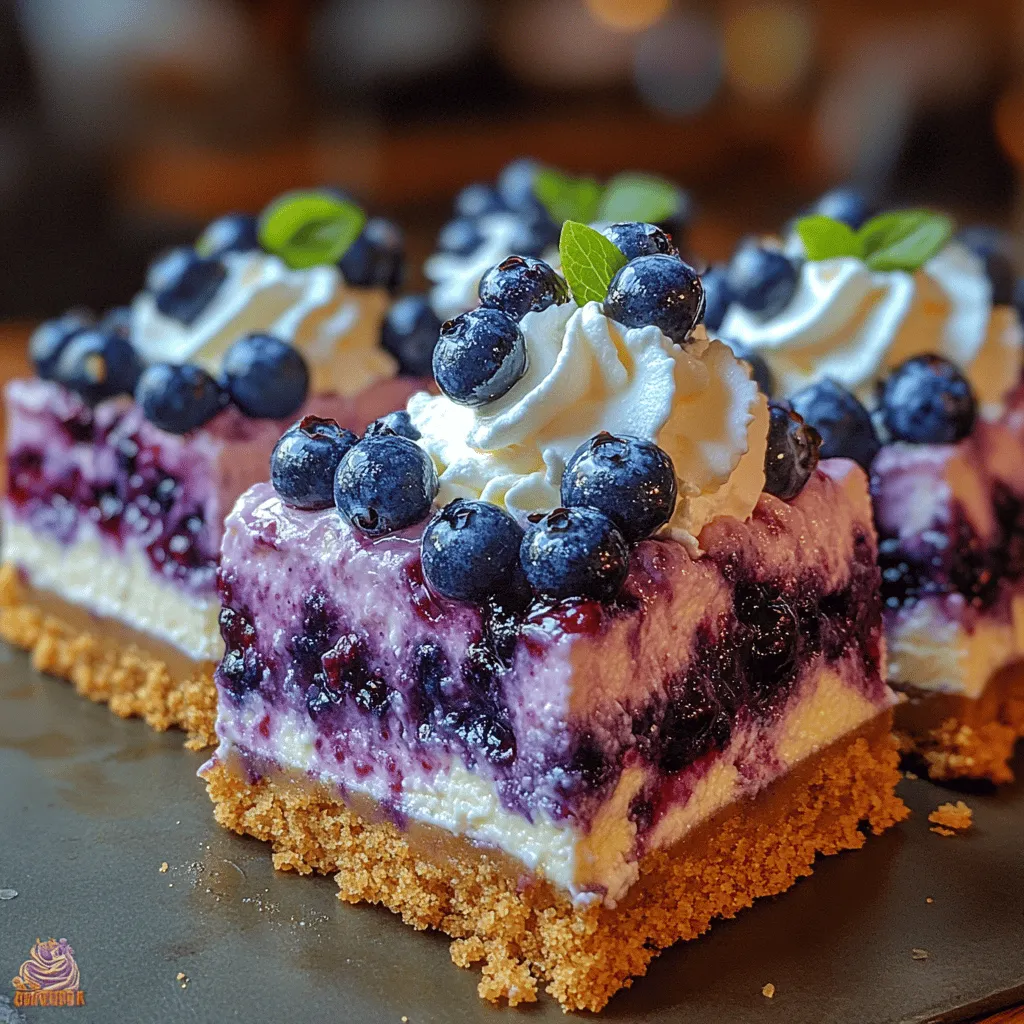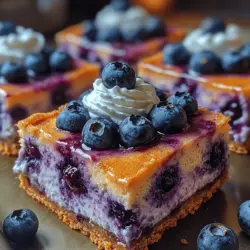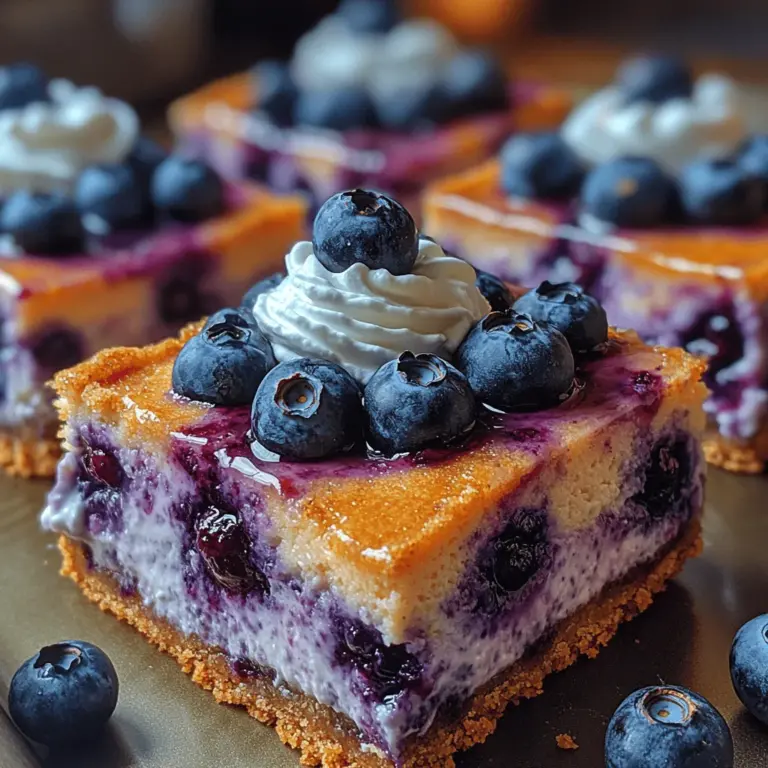Introduction
Welcome to the world of indulgent desserts where flavors come together to create a slice of heaven! Today, we’re diving into the delightful realm of Luscious Blueberry Cheesecake Bars. These bars are not just a sweet treat; they are a celebration of the vibrant taste of fresh blueberries combined with the creamy richness of cheesecake. Perfect for summer gatherings, potlucks, or a cozy night in, these cheesecake bars are sure to impress both your family and friends.
Brief Overview of the Recipe
This recipe for blueberry cheesecake bars features a buttery graham cracker crust, a velvety cream cheese filling, and a luscious blueberry topping that is both refreshing and decadent. The combination of sweet and tangy blueberries cuts through the richness of the cheesecake, creating a balanced dessert that is hard to resist. Each bite is a burst of flavor, making these bars an irresistible choice for any occasion.
Whether you are an experienced baker or a novice in the kitchen, this recipe is straightforward and easy to follow. With just a few steps, you can whip up a batch of these stunning cheesecake bars that look as beautiful as they taste. As you embark on this culinary adventure, remember that the quality of your ingredients plays a significant role in the outcome of your dessert.
Importance of Using Quality Ingredients
When it comes to making blueberry cheesecake bars, the quality of your ingredients can significantly affect the final product. Fresh blueberries are essential for achieving that vibrant color and flavor that makes this dessert stand out. Opt for plump, ripe blueberries that are in season for the best taste. If fresh berries are unavailable, frozen blueberries can be used, but make sure to thaw and drain them properly to avoid excess moisture in your filling.
Additionally, using high-quality cream cheese is crucial for a rich and creamy filling. Look for full-fat cream cheese for the best results, as it will yield a smoother texture and intense flavor. The same goes for your graham crackers; choose a brand that uses simple ingredients, avoiding any artificial additives.
Lastly, don’t skimp on the sugar and vanilla extract. These components enhance the overall flavor profile of your cheesecake bars, ensuring each bite is a delightful experience. Remember, the better the ingredients, the more delicious your dessert will be!
The Joy of Making Dessert from Scratch
There is something incredibly satisfying about creating a dessert from scratch. The process allows you to embrace your creativity while honing your baking skills. Making blueberry cheesecake bars from scratch not only gives you control over the ingredients but also allows you to customize the flavors to your liking. Whether you want to add a hint of lemon zest for brightness or swap out the blueberries for another berry, the possibilities are endless.
Baking can also be a therapeutic activity—mixing, pouring, and baking can be a form of meditation, allowing you to unwind and focus on the task at hand. Plus, sharing your homemade creations with loved ones brings a sense of joy and accomplishment that store-bought treats simply cannot replicate. So, gather your ingredients, roll up your sleeves, and let’s get started on this delicious journey!
Understanding the Basics of Cheesecake Bars
Before diving into the recipe, it’s essential to understand the fundamentals of making cheesecake bars. This knowledge will not only help you achieve the best results but also enhance your overall baking experience.
The History of Cheesecake: A Culinary Journey
Cheesecake has a rich history that dates back thousands of years. Its origins can be traced back to ancient Greece, where it was served to athletes during the first Olympic Games as a source of energy. The Romans later adopted the recipe, spreading it throughout Europe. Over time, different cultures added their unique twists to the classic dessert, resulting in the many variations we enjoy today.
In the United States, cheesecake gained popularity in the 19th century, thanks to the introduction of cream cheese. This creamy version quickly became a favorite, leading to the creation of iconic New York-style cheesecake. Today, cheesecake is celebrated in countless forms, from traditional slices to bars, making it a versatile dessert that can be enjoyed in various settings.
Different Types of Cheesecake and Their Uses
Cheesecake comes in various forms, each offering a unique texture and flavor profile. Some popular types include:
1. Classic New York Cheesecake: Dense and creamy, often served plain or with fruit toppings.
2. No-Bake Cheesecake: A lighter alternative that uses whipped cream or whipped topping for a fluffy texture.
3. Baked Cheesecake: Made with eggs, which helps create a rich and custard-like filling.
4. Fruit-Top Cheesecake: Topped with fresh fruit or fruit compote, adding sweetness and freshness to the richness of the cheese.
For this recipe, we will focus on a baked cheesecake bar that incorporates fresh blueberries, creating a delightful combination of flavors that everyone will love.
Essential Ingredients for Blueberry Cheesecake Bars
Now that we have a grasp on the history and variations of cheesecake, let’s delve into the essential ingredients for making these luscious blueberry cheesecake bars.
Graham Cracker Crust
The foundation of any cheesecake bar is the crust. For our blueberry cheesecake bars, we will use crushed graham crackers, which provide a buttery, sweet base that complements the creamy filling. You can make your own by crushing whole graham crackers or use store-bought crumbs for convenience.
Cream Cheese
The star of the show! Cream cheese gives our cheesecake bars their rich and creamy texture. Make sure to use full-fat cream cheese for the best results, as lower-fat varieties may result in a less desirable texture.
Sugar
Granulated sugar is essential for sweetening both the crust and the filling. It balances the tanginess of the cream cheese and enhances the overall flavor of the dessert.
Eggs
Eggs help bind the filling together and contribute to the creamy texture. They also provide structure, ensuring that our cheesecake bars hold their shape once baked.
Fresh Blueberries
Fresh blueberries bring a burst of flavor and color to our dessert. They can be folded into the cheesecake filling or used as a topping for added freshness.
Vanilla Extract
A splash of pure vanilla extract enhances the overall flavor of the cheesecake, adding a lovely aromatic note that elevates the dessert.
Lemon Juice (Optional)
A small amount of lemon juice can brighten the flavor of your cheesecake, balancing the sweetness with a hint of acidity. This is optional but highly recommended for those who enjoy a zesty kick.
Flour: Choosing the Right Type
While our cheesecake filling doesn’t require flour, it is important to note that some recipes may call for flour to stabilize the filling. If you choose to incorporate flour, all-purpose flour works best as it provides the right texture without altering the flavor of the cheesecake.
Eggs: Fresh vs. Store-Bought
When it comes to eggs, fresh, high-quality eggs are always the best option. They contribute to the overall richness and texture of your cheesecake. If you have access to farm-fresh eggs, use those for an enhanced flavor experience.
Salt: Enhancing Flavor
A pinch of salt is often added to desserts to enhance and balance flavors. It’s a small but vital ingredient that helps to bring out the sweetness of the sugar and the richness of the cream cheese.
Water: When and Why to Use It
Water is typically not a primary ingredient in cheesecake bars; however, it may be used when preparing a water bath for baking. A water bath helps regulate the temperature while baking, ensuring even cooking and preventing cracks in your cheesecake.
Tools and Equipment for Making Cheesecake Bars
To create your luscious blueberry cheesecake bars, it’s essential to have the right tools and equipment on hand. Here’s a list of must-have items that will make the process smoother and more enjoyable.
Essential Tools for Homemade Cheesecake Bars
1. Mixing Bowls: A set of mixing bowls in various sizes will help you prepare your crust and filling separately.
2. Electric Mixer: A hand or stand mixer is crucial for achieving a smooth and creamy cheesecake filling.
3. Measuring Cups and Spoons: Accurate measurements are key to successful baking, so ensure you have these on hand.
4. Rubber Spatula: A spatula is excellent for scraping down the sides of your mixing bowl and folding in the blueberries.
5. Baking Pan: A 9×9 inch square baking pan is perfect for this recipe. Make sure to line it with parchment paper for easy removal.
6. Cooling Rack: Once baked, allowing your cheesecake bars to cool properly is important for achieving the right texture.
Optional Tools for the Enthusiast
1. Parchment Paper: Lining your baking pan with parchment paper makes it easier to lift out the cheesecake bars once they’ve cooled.
2. Food Processor: If you prefer a finer graham cracker crust, a food processor can quickly crush the crackers to the desired consistency.
3. Offset Spatula: This tool can help you spread the cheesecake filling evenly in the pan for a beautifully smooth top.
Step-by-Step Guide to Making Blueberry Cheesecake Bars
With the ingredients and tools ready, it’s time to dive into the step-by-step process of making luscious blueberry cheesecake bars. Follow these instructions carefully for a successful outcome that you can be proud of!
Preparing the Dough
1. Prepare Your Baking Pan: Preheat your oven to 325°F (163°C). Line a 9×9 inch baking pan with parchment paper, allowing some overhang on the sides for easy removal later.
2. Make the Graham Cracker Crust: In a mixing bowl, combine crushed graham crackers with melted butter and sugar. Mix until the crumbs are evenly coated and resemble wet sand. Pour this mixture into the prepared baking pan and press it firmly into the bottom to create an even layer. Bake the crust for about 10 minutes or until lightly golden. Remove from the oven and let it cool.
Measuring Ingredients Accurately
While your crust is cooling, measure out your ingredients for the cheesecake filling. Accurate measurements are crucial for achieving the right texture and flavor balance in your bars.
Mixing Cream Cheese and Sugar
In a large mixing bowl, beat the cream cheese until smooth and creamy, using an electric mixer on medium speed. Gradually add in the granulated sugar, mixing until fully incorporated and fluffy. Scraping the sides of the bowl occasionally helps to ensure everything is well combined.
Adding Eggs and Flavorings
Add the eggs one at a time, mixing on low speed after each addition until just combined. Overmixing can introduce air into the batter, leading to cracks during baking. Then, add in the vanilla extract and lemon juice if using, mixing until everything is well blended.
Incorporating the Blueberries
Gently fold in the fresh blueberries with a rubber spatula, being careful not to break them apart. This will give your cheesecake bars a beautiful marbled effect and pockets of juicy fruit.
Pouring the Filling Over the Crust
Once your filling is ready, pour it over the cooled graham cracker crust, spreading it evenly with the spatula. Smooth out the top to ensure a nice finish once baked.
Baking the Cheesecake Bars
Bake the cheesecake bars in the preheated oven for 30-35 minutes, or until the edges are set and the center has a slight jiggle. Remember, the bars will continue to set as they cool, so it’s important not to overbake them.
Cooling and Setting
After baking, remove the cheesecake bars from the oven and let them cool in the pan on a wire rack. Once they reach room temperature, refrigerate for at least 4 hours, or overnight, to allow the flavors to meld and the texture to firm up.
Once set, you can lift the bars out of the pan using the parchment paper overhang, slice them into squares, and serve them chilled or at room temperature.
Stay tuned for the next part of this article, where we will explore some tips for achieving the best results and answer common questions about blueberry cheesecake bars. Enjoy the process of creating your masterpiece, and prepare to delight your taste buds with this luscious dessert!



